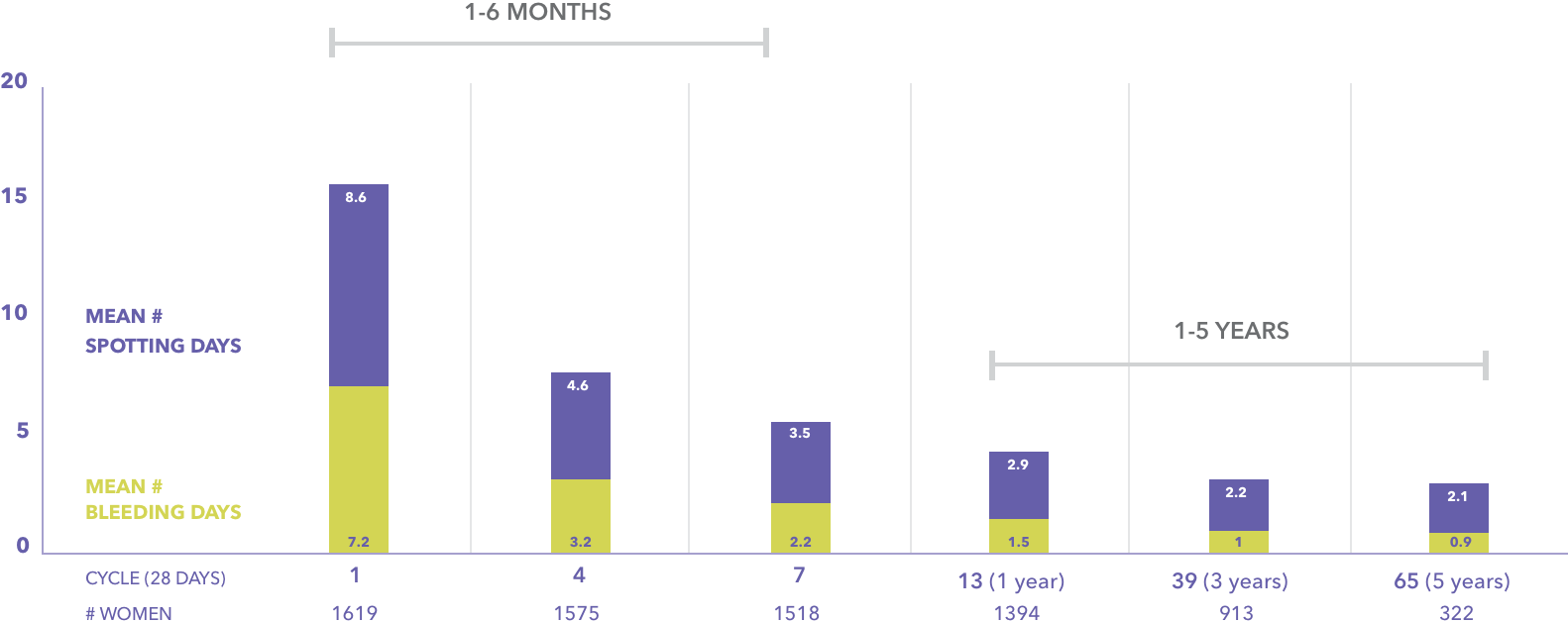IMPORTANT SAFETY INFORMATION
Who is not appropriate for Kyleena: Use of Kyleena is contraindicated in women with: known or suspected pregnancy and cannot be used for post-coital contraception; congenital or acquired uterine anomaly, including fibroids if they distort the uterine cavity; known or suspected breast cancer or other progestin-sensitive cancer, now or in the past; known or suspected uterine or cervical neoplasia; liver disease, including tumors; untreated acute cervicitis or vaginitis, including lower genital tract infections (e.g., bacterial vaginosis) until infection is controlled; postpartum endometritis or infected abortion in the past 3 months; unexplained uterine bleeding; current IUD; acute pelvic inflammatory disease (PID) or history of PID (except with later intrauterine pregnancy); conditions increasing susceptibility to pelvic infection; or hypersensitivity to any component of Kyleena.
Clinical considerations for use and removal of Kyleena
Use Kyleena with caution after careful assessment in patients with coagulopathy or taking anticoagulants; migraine, focal migraine with asymmetrical visual loss, or other symptoms indicating transient cerebral ischemia; exceptionally severe headache; marked increase of blood pressure; or severe arterial disease such as stroke or myocardial infarction. Consider removing the intrauterine system if these or the following arise during use: uterine or cervical malignancy or jaundice. If the threads are not visible or are significantly shortened they may have broken or retracted into the cervical canal or uterus. If Kyleena is displaced (e.g., expelled or perforated the uterus), remove it. Kyleena can be safely scanned with MRI only under specific conditions.
Pregnancy related risks with Kyleena
If pregnancy should occur with Kyleena in place, remove the intrauterine system because leaving it in place may increase the risk of spontaneous abortion and preterm labor. Advise her of isolated reports of virilization of the female fetus following local exposure to LNG during pregnancy with an LNG IUS in place. Removal or manipulation may result in pregnancy loss. Evaluate women for ectopic pregnancy because the likelihood of a pregnancy being ectopic is increased with Kyleena. Also consider the possibility of ectopic pregnancy in the case of lower abdominal pain, especially in association with missed menses or if an amenorrheic woman starts bleeding. Tell women about the signs of ectopic pregnancy and associated risks, including loss of fertility. Women with a history of ectopic pregnancy, tubal surgery, or pelvic infection carry a higher risk of ectopic pregnancy.
Educate her about PID
Kyleena is contraindicated in the presence of known or suspected PID or in women with a history of PID unless there has been a subsequent intrauterine pregnancy. IUDs have been associated with an increased risk of PID, most likely due to organisms being introduced into the uterus during insertion. Promptly examine users with complaints of lower abdominal pain or pelvic pain, odorous discharge, unexplained bleeding, fever, genital lesions or sores. Inform women about the possibility of PID and that PID can cause tubal damage leading to ectopic pregnancy or infertility, or infrequently can necessitate hysterectomy, or cause death. PID is often associated with sexually transmitted infections (STIs). Kyleena does not protect against STIs, including HIV. PID may be asymptomatic but still result in tubal damage and its sequelae.
In clinical trials with Kyleena PID occurred more frequently within the first year and most often within the first month after insertion.
Expect changes in bleeding patterns with Kyleena
Spotting and irregular or heavy bleeding may occur during the first 3 to 6 months. Periods may become shorter and/or lighter thereafter. Cycles may remain irregular, become infrequent, or even cease. Consider pregnancy if menstruation does not occur within 6 weeks of the onset of previous menstruation.
If a significant change in bleeding develops during prolonged use, take appropriate diagnostic measures to rule out endometrial pathology.
Be aware of other serious complications and most common adverse reactions
Some serious complications with IUDs like Kyleena are sepsis, perforation and expulsion. Severe infection or sepsis, including Group A streptococcal sepsis (GAS), have been reported following insertion of a LNG-releasing IUS. Aseptic technique during insertion of Kyleena is essential in order to minimize serious infections, such as GAS.
Perforation (total or partial, including penetration/embedment of Kyleena in the uterine wall or cervix) may occur, most often during insertion, although the perforation may not be detected until sometime later. The risk of uterine perforation is increased in women who have recently given birth, and in women who are breastfeeding at the time of insertion. In a large US retrospective, postmarketing safety study of IUDs, the risk of uterine perforation was highest when insertion occurred within ≤6 weeks postpartum, and also higher with breastfeeding at the time of insertion. The risk of perforation may be increased if inserted when the uterus is fixed, retroverted or not completely involuted. If perforation occurs, locate and remove Kyleena. Surgery may be required. Delayed detection or removal of Kyleena in case of perforation may result in migration outside the uterine cavity, adhesions, peritonitis, intestinal perforations, intestinal obstruction, abscesses, and erosion of adjacent viscera. In addition, perforation may reduce contraceptive efficacy and result in pregnancy.
Partial or complete expulsion of Kyleena may occur resulting in the loss of contraceptive protection. The risk of expulsion is increased with insertions immediately after delivery and appears to be increased with insertion after second-trimester abortion based on limited data. In the same postmarketing study, the risk of expulsion was lower with breastfeeding status. Remove a partially expelled IUD. If expulsion has occurred, a new Kyleena can be inserted any time the provider can be reasonably certain the woman is not pregnant.
Ovarian cysts may occur and are generally asymptomatic, but may be accompanied by pelvic pain or dyspareunia. Evaluate persistent enlarged ovarian cysts.
In clinical trials with Kyleena the most common adverse reactions (≥5%) were vulvovaginitis (24%), ovarian cyst (22%), abdominal/pelvic pain (21%), headache/migraine (15%), acne/seborrhea (15%), dysmenorrhea/uterine spasm (10%), breast pain/breast discomfort (10%), and increased bleeding (8%).
Teach patients to recognize and immediately report signs or symptoms of the aforementioned conditions. Evaluate patients 4 to 6 weeks after insertion of Kyleena and then yearly or more often if clinically indicated.
For important information about Kyleena, please see the Full Prescribing Information.







